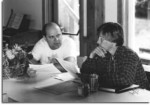*Faculty Institutes for Reforming Science Teaching Through Field Stations
Project FIRST is designed to develop and sustain a model for faculty professional development that will increase the quality of undergraduate science teaching and learning for all students, and especially those preparing for careers as elementary and secondary school teachers, who may take only two or three natural science courses.
"Faculty who teach undergraduate biology should learn how to use strategies that promote learning science through inquiry, so these future teachers can in-turn pass on experience and knowledge to future generations," says Diane Ebert-May, past president of ESA’s education committee and chair of the LTER Education Committee. Together with Janet Hodder, Academic Coordinator at the University of Oregon’s Institute of Marine Biology Diane has developed a program utilizing field stations and marine laboratories to enhance biology education.
Project FIRST will prepare faculty associated with field stations to utilize inquiry-based, active learning approaches for reforming undergraduate biology courses and curriculum. "Field stations are inherently conducive to the process of education," says Terry Detling, leader of the Hancock Biological Station FIRST team. "Students have an a priori expectation that field stations involve investigation of the natural environment, asking questions for which there are no established answers, and learning."
Diane Ebert-May has been a leader in the reform of undergraduate biology education throughout her research and university faculty career. "While holding responsibility for educating our citizens in the biological sciences," Diane says, "most scientists and graduate students are unaware of instructional strategies about teaching for learning." Most university faculty are rewarded to conduct research and publishing rather than develop comparable excellence in teaching science to undergraduates.
Field stations are places where students can go to have real "hands-on/minds-on activities," say Kathy Williams, associate professor of biology, San Diego State University, and FIRST team leader there. "They can make observations, develop hypotheses to explain their observations, then design ways to test those hypotheses, and do it. These are a far cry from cookbook labs that many students have experienced and dread."
Forming a Network of Support
Five field stations:
- St. Croix Watershed Research Station, Science Museum of Minnesota
- Southwestern Research Station, American Museum of Natural History, Portal, Arizona
- San Diego State University Field Stations, San Diego, California
- Hancock Biological Station, Murray State University, Murray, Kentucky
- Archbold Biological Station, Lake Placid, Florida
established leadership teams composed of researchers, faculty, and science educators. The teams participated in two workshops, during which they learned about and experimented with forms of active learning, developed inquiry-based field activities, and studied multiple forms of assessment that would provide evidence of student learning. During the first year, the leadership team recruited five ‘institutional teams’ from colleges and universities from the region near the field station, or in one case, from different universities in states far from the station. The leadership teams designed and implemented faculty development workshops at their own field stations for the institutional teams.
"The bottom line," says Diane, "is that faculty who understand the educational value of field stations to promote scientific literacy by all students began to develop long-term plans for reforming their undergraduate science curriculum in their departments. Not only did they consider adding field components to their course, but also designed ways to bring the field into their classrooms on a more regular basis."
These institutional teams will then begin to reform the teaching and learning in their courses. One member from the project staff will work at the field station with the FSML team to support implementation of the professional development institutes. This will ensure a smooth transition and immediate feedback for FSML teams.
Ultimately, all students will have opportunities to gain scientific understanding by direct experiences with the methods and process of inquiry both in a field station/ field site situation and in their own classrooms.
Overcoming Obstacles
As in most research institutions, the incentives are for research and not for education. There are direct payoffs for expending efforts on research (i.e., salary and prestige associated with grant money and publications, tenure and promotion). "Most educators at field stations believe their courses are already inquiry-based and that training in pedagogy and alternative methods is not of value to them," Terry Detling says, which, she adds, differs little from views expressed by faculty in traditional educational institutions.
"Perhaps the most influential effect will be grant support for teaching activities," says Terry, who adds that several field-station faculty at Hancock recently received a large Collaborative Research at Undergraduate Institutions grant from NSF, which focuses on research experiences for undergraduates, using the field station as the research base. "This grant got a lot of attention in our department... [and] may encourage others to submit proposals that combine education and research. As faculty carry out the proposed activities with students, and hopefully find it to be a positive and rewarding experience, attention to research AND education may increase."
Kathy Williams says the new teaching methods are "contagious" at SDSU. "The students and faculty both enjoy the change so much that others take notice and want to try changing their traditional courses as well." Williams notes that spending time to reform a tried-and-true course curriculum is not attractive to many faculty, but the results are rewarding. "Actually I don’t know of anyone who’s tried these reforms and has gone back to ‘passive’ education."

 Enlarge this image
Enlarge this image